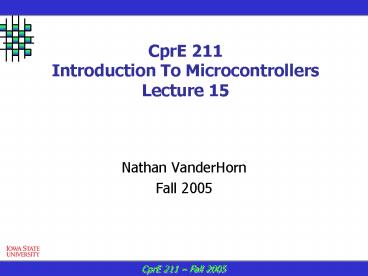CprE 211 Introduction To Microcontrollers Lecture 15 - PowerPoint PPT Presentation
1 / 15
Title:
CprE 211 Introduction To Microcontrollers Lecture 15
Description:
Student questions example. Polling Ask students for questions, raise hands, gather information ... is extremely simple consisting of only a data register ... – PowerPoint PPT presentation
Number of Views:36
Avg rating:3.0/5.0
Title: CprE 211 Introduction To Microcontrollers Lecture 15
1
CprE 211 Introduction To MicrocontrollersLecture
15
- Nathan VanderHorn
- Fall 2005
2
Input Output Programming
- Communication with external devices
- How does the processor know an external device is
requesting communication we will focus on two
methods - Polling keep checking the status of external
devices - Interrupt external device signals processor
that service is requested - Student questions example
- Polling Ask students for questions, raise
hands, gather information - How many questions?
- Order in which to service questions?
- Interrupt Student interrupts lecture with
question - Service question immediately
- What happens if a question interrupts the current
question - Interrupts can be more difficult
3
Methods for I/O Programming
- Sampling
- Simple devices in which the device is always
ready to accept or provide data - The interface is extremely simple consisting of
only a data register - Examples are temp sensors, motor control port
- Polling
- Requires data and status/control registers
- Status is read by the microcontroller and denotes
status of device - Control is written by microcontroller to indicate
the characteristics of communication baud rate,
operation mode etc. - Interrupt
- Device interrupts the microcontroller when
service is needed - Control is passed to the device if interrupts are
enabled - Software handles the operations to be performed
4
Communication Examples
- Keyboard
- Processor ? keyboard data ready? read-data?
- Keyboard ? processor data ready
- Hard disk
- Processor ? disk seek sector, seek track,
read/write block - Disk ? processor data-ready, error conditions
bad block - Printer
- Processor ? printer data-sent, print, font,
resolution? - Printer ? processor printing done, error
conditions out of paper, toner
5
Dealing with I/O
- Should we include instructions for communications
with external devices? - Is there enough uniformity between I/O devices to
agree on a single set of instructions to
communicate with them? - How about the I/O devices we have not even
foreseen yet? - Hard to develop an instruction set to control
todays and tomorrows devices! - Necessity for a generic method to communicate
with all devices
6
Memory Mapped I/O
Peripherals
- How should the Processor communicate with the I/O
devices - Will every device communicate in the same way?
- Need a generic method for accessing external
devices
Keyboard
Bus
Mouse
Processor
Printer
A/D converter
Other Device
7
Memory Mapped I/O
- Generic control
- Make the interface between the I/O device
processor soft - Develop each devices control as a unique data
structure - Specify a place in memory for these control and
data registers
8
Keyboard Example
- Getchar() gets an ASCII byte from the keyboard
and puts it into r3 - Assume r13? 0xF000 0000
- Assembly code for Getchar()
- poll
- lwz r4, 0(r13)
- andi. r4, r4, 1
- beq poll
- getchar
- lbz r3, 4(r13)
Processor
Keyboard
Data register
0xF000 0004
0xF000 0000
Control Register
R
9
Polling
- We have just seen how polling works with a
keyboard example - Is it efficient to poll?
- Sometimes yes sometimes no
- Depends upon the application
10
Why Interrupt I/O
- Polling is what we have seen
- main ()
- while(1)
- PollKeyboard()
- Polling the keyboard
- Read port to see if a key is pressed
- Must poll every n ms, the minimal time period a
key is pressed otherwise keystroke is lost
- If the program has tasks to do
- main ()
- task1()
- PollKeyboard()
- task2()
- PollKeyboard()
- Overhead polling frequency polling overhead
- Difficulty Hard to mix polling with a normal
process
11
Generic Programming Model with Interrupts
start
Interrupt
Interrupt
Interrupt
Initialize
ISR for task 1
ISR fortask 2
ISR fortask 3
Wait for events
I-return
I-return
I-return
Processing
Memory
How to support interrupt programming? How to
write interrupt-based C and Assembly code?
12
Understanding Interrupts
- Normal control flow
- Exception control flow
- Exception and Interrupts
- Hardware implementation of interrupts
- Machine level interrupt programming
13
Normal Control Flow
- In a processor, the program counter (PC) takes a
sequence of values - a0, a1, , an-2, an-1
- where each ak is the address of an instruction
Ik. - Control transfer each transition from ak to
ak1 - Flow of control, or control flow sequence of
control transfers - Smooth control flow Ik and Ik1 are adjacent
in memory - Changes to smooth flow Ik1 not adjacent to Ik
- Branches
- Calls, returns
14
Exceptional Control Flow (ECF)
- Abrupt changes in control flow not caused by
program statements and variables Ik1 is
external to the program - Hardware timer goes off at regular intervals
- I/O request completes, e.g., A/D conversion, disk
I/O - Packets arrive at network adapter
- Instruction attempts divide by zero
- Virtual memory page fault occurs
- Memory access violation
- Exceptions occur at all levels in a computer
system hardware, operating system, user
15
Exceptions
- DEFINITION an abrupt change in the control flow
in response to some change in the processors
state - Event change in processors state, where state
is encoded in various bits and signals inside the
processor - Event might be related or unrelated to current
instruction - Implementation details vary from system to system

